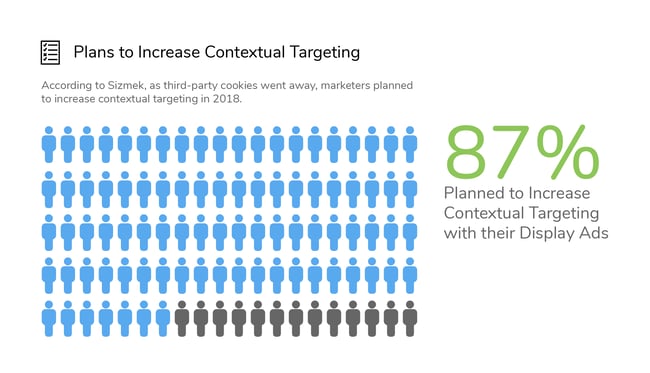Third-Party Cookies Are Dead: How to Advertise Post-Privacy
March 11, 2020 •Jordan Ehrlich

Understanding consumer behavior is life or death for today’s business. Now more than ever, it’s clear that companies who understand their target audience stay in business, and those who don’t... don’t. And because of this, as marketers we obsess over any consumer insights we can get our hands on. We do anything we can to get our content in front of the right eyeballs - to reach consumers when it matters most, with the content they actually care about.
(Click here to get free insights on your target audience.)
As advertisers, how do we do it?
Most often with the help of cookies, third-party cookies specifically.

Internet cookies are at the core of our display advertising practices. With them, we identify and advertise to any targeted audience we want with the click of a button. Until a couple years ago, it seemed we were in the golden age of effective advertising. Unfortunately, a shift is well underway. Consumers, governments, and (interestingly enough) tech companies are pushing back against the beloved cookie.
In the last couple of years, we’ve seen governments limit pervasive consumer tracking with GDPR, CCPA, and similar legislation. We’ve seen Safari and Firefox remove third-party cookies by default. And more recently, we’ve seen Google announce plans to do just the same.
It’s 2020 and the world has turned against internet cookies with protecting consumer privacy as its cause.
Could this be the end of effective display advertising as we know it? Or will marketers find smarter tactics to efficiently reach consumers when it matters most?
Why is removing third-party cookies bad for advertisers?
The elimination of third-party cookies limits advertisers’ abilities to target specific audiences with their ads. When cookies are removed from browsers automatically, there’s no way for advertisers to identify consumers based on previous behavior. We can no longer say, “put my ad in front of 25 year old single college grads interested in getting a dog.”
To put this limitation in perspective, let’s look at what Safari’s crackdown on third-party cookies did to Criteo’s revenue in 2018, one of the big retargeting providers. When Safari announced it’s ITP update, which more aggressively removed third-party cookies from their browser, Criteo announced that it expected to lose 20% of its 2018 revenue as a result - a.k.a. hundreds of millions of dollars.
This is because when third-party cookies are removed from the equation, we can’t trust that our ads are getting in front of the right audiences anymore. The data’s bad, so we don't buy it. We turn to contextual targeting solutions instead.

In fact, in the heat of the first wave of cookie elimination, 87% of marketers planned to increase their contextual targeting in the next 12 months, according to one 2018 Sizmek Study.
But DemandJump has found a solution that increases display performance beyond that which even contextual targeting can achieve.
How can advertisers get ahead in the age of internet privacy?
Imagine being able to align your display ads with consumer intent like you can with paid search. By pasting a whitelist into your DSP, you’d be able to show ads to consumers in the exact moment they’re interested in your products.
Using the DemandJump platform to do exactly that, our customers are changing the reputation of display and creating transformative results. For example...
Cummins, American Fortune 500 power systems supplier, saw:
- 250% increase in Clickthrough Rate
- 62% decrease in Cost Per Conversion
- 231% increase in Conversions
SkyZone, International chain of indoor trampoline parks, saw:
- 184% Increase in Clickthrough Rate
- 17% Decrease in Cost Per Click
Reach out to see how you can achieve these results with DemandJump
Why does this approach work so well?
Instead of tracking where consumers have been to figure out what they might be interested in (then hoping our ads still resonate), DemandJump considers where consumers are to understand what ads they’ll welcome and pay attention to in the moment. This form of ad targeting leverages dozens of sources of internet data, completely independent of cookies, to understand consumer intent when they visit websites, then prioritizes a list of websites where your ads are guaranteed to perform best.
This approach works so well in our cookie-less future because it removes the need for individual consumer data from the equation. It instead analyzes the contents of websites, the sources of traffic to those websites, and how those sites are connected to others. And what it spits out is a list of websites that are guaranteed to boost your brand’s display performance.
If you’d like to give this approach to display advertising a try, reach out to DemandJump. We’re happy to help you deliver relevant advertisements without invading anyone’s privacy.
What are internet cookies?
The term cookies refers to lines of code that are placed on your computer by another website. These cookies log information regarding your internet activity for a variety of future uses. This information is often used to provide a positive user experience if you ever revisit a website. But the specific use, and beneficiary, of this cookie data depends on who places the cookie.

What are first-party cookies?
First-party cookies are placed on your computer by the website you are visiting at the time. Similarly, they can only be read by the website creating the cookie - so they are useless to advertisers (see below for more information). As touched on above, first-party cookies help provide a positive user experience to the website visitor, for example, by remembering what you’ve added to your shopping cart when returning to an eCommerce website. They might also help a website tailor content to your interests based on what you’ve looked at on their site in the past.
What are third-party cookies?
Third-party cookies are stored on your computer by websites other than the one you are visiting at the time, and are largely used for advertising purposes. They’re what allow us advertisers to target specific audiences with our ads.
One common use of third-party cookies is for retargeting purposes. In this case, they are placed by an adtech vendor. These third-party cookies are what enable companies to advertise to you with products you recently checked out on their website. They often stay on your browser so that other advertisers can identify your interests and advertise to you with products you might like.
Another way third-party cookies are stored are by social sharing icons. When you are on a website and want to share the blog you are reading, you are often given the opportunity to do so with a variety of social buttons. This ability is provided by an other tech provider than the website you are on and allows this third-party to remember that you’ve been to this website. They can then sell this information to advertisers wishing to target you and others like you who have been to such websites in the past.
Featured Articles
Categories
- Attribution Tracking (13)
- Channel Optimization (11)
- Consumer Insights (68)
- Content Marketing (251)
- Data Science (8)
- Digital Marketing (6)
- Digital Transformation (26)
- Enterprise (10)
- Lead Generation (14)
- Market Intelligence (8)
- Marketing Analytics (39)
- Marketing Attribution (57)
- Marketing Management (153)
- Marketing Operations (86)
- Organic Search (222)
- Paid Search (52)
- Pillar-Based Marketing (63)
- Programmatic Advertising (9)
- SaaS Content (14)
- SaaS Marketing (29)
- Search Marketing (111)
- SEO Keyword Research (28)
- SEO Pillar (18)
- SEO Strategy (46)
- SMB (5)
- Website Content (12)


